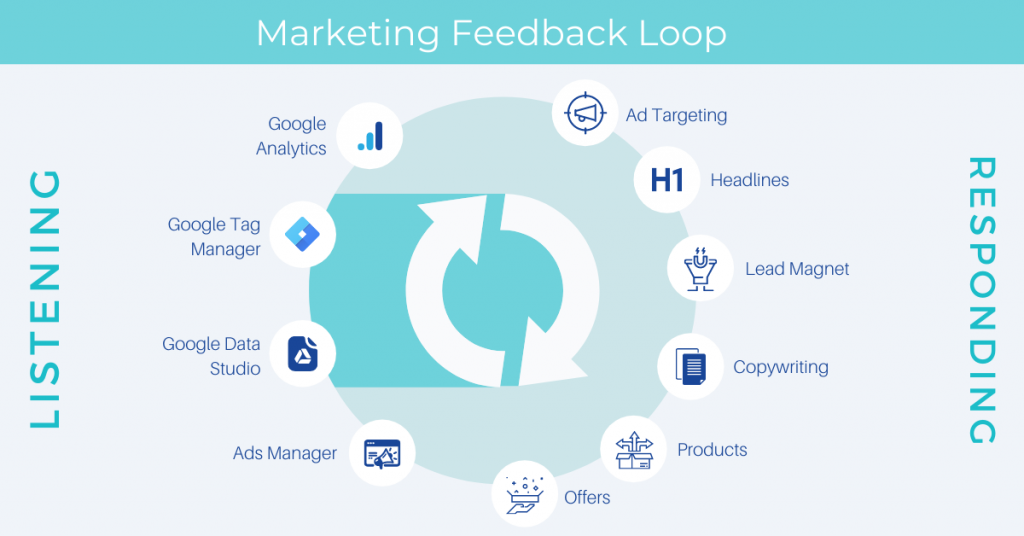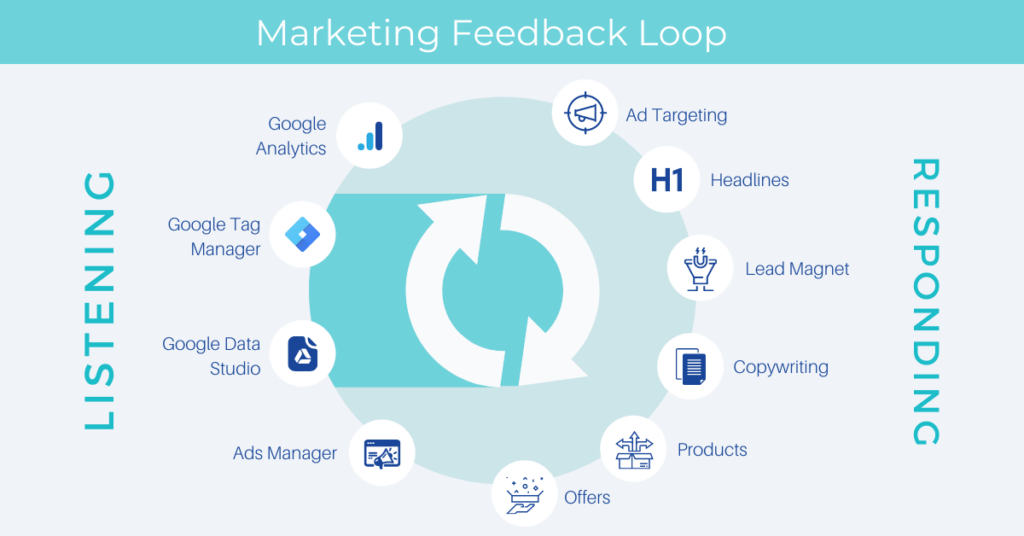For decades, the typical sales process involved salespeople meeting clients face to face, having a conversation, and then selling or not selling. In today’s marketplace, selling has shifted online. Websites now augment the sales process and sometimes even replace it entirely. The challenge is in supplementing or replicating one-on-one personalized interactions online.
As marketers, how do we create the best online experience possible for our customers? By being in tune with their online behaviours while they visit a website before or during the sales process. It’s important to be consistent in listening to their side of the conversation to help create a marketing feedback loop. This loop enables marketers to actively observe customer behaviours in real-time so we can respond proactively and create customer-centric online experiences.
Measurement marketing is the process of actively listening and responding accordingly based on the online behaviour of customers. Measuring marketing effectiveness is one of the most effective agile marketing tools.
Agile marketing is the act of breaking down a marketing plan into smaller weekly, biweekly, or monthly sprints. Each sprint represents a detailed marketing action plan for the team that allocates who is responsible for each task. The outcome of these sprints is micro-campaigns that gather feedback and data to quantify what is needed to take the next step: creating bigger budget campaigns with bigger audiences, as they’re already test-driven, rooted in quantifiable data, and proven to generate the most sales (conversions).
The benefits of using measurement marketing as a feedback loop are as follows:
- Increasing sales conversions with major marketing campaigns that are data-driven instead of reliant on a “spray and pray” approach
- Prioritizing the most important tactics for the marketing team
- Identifying the points where people disengage from landing pages and drop out of the sales funnel, which will help with marketing copy, image, and/or video revisions
- Customizing remarketing campaigns based on website behaviour to tailor the experience and increase the conversation rate for retargeting campaigns
- Ensuring that the offers presented on the website convert into the most leads possible

Listening to online customers can include the following:
- Determining how long they stay on particular webpages and how often they bounce off them
- Determining how far down they scroll pages
- Determining hether they are watching videos and for how long
- Determining how long they stay on the website overall
- Monitoring the engagement flow into and through online sales funnels (conversion rates)
- Measuring the open rates and click-through rates from email campaigns
- Conducting one-on-one interviews with prospects to get website experience feedback
- Watching screen recordings of user visits to the website to see where they get stuck
- Monitoring the pages of the website where the most traffic exits
All of these examples are measurable and can therefore enable marketers to act accordingly in response. The tools that marketers use for this purpose include Google Analytics, Facebook Ads Manager, Google Ad Manager, Google Data Studio, Google Tag Manager, Hotjar, one-on-one interviews with customers, and more.
This is often a challenging part of the process for many marketers because the numbers can be intimidating. It’s important to understand that the behaviours live behind the numbers. We need to look through the numbers to see customer behaviours and to seek the patterns and differences in behaviours so we can find the stories the numbers are telling us. These stories help us determine the next action steps.
Responding to these observations from the marketing feedback loop and converting them into an action plan doesn’t have to happen at the same time. We can place them in sequential order to implement in a weekly, biweekly, or monthly sprint plan using an agile marketing approach.
The marketing implementation plan for the subsequent sprints in response to customer behaviours can include tasks such as the following:
- Split testing (or A/B testing) landing page copy
- Testing a different lead magnet (typically a freebie) in exchange for customer email addresses
- Swapping out a sales video for a new one that’s more relevant or relatable to customers
- Changing the call to action or the offer on a key landing page
- Editing page copy or page structure based on where engagement drops on the landing or product page
At our agency, we categorize the tasks into the top, middle, and bottom of the sales funnel and prioritize them so we can create an order in which we will execute the plan. This agile marketing approach using a sprint schedule enables us to continuously listen to and respond to customers.
If you’re seeking an agency that uses a data-driven approach to marketing, contact us today for a consultation.

